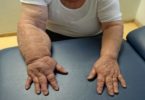What's in this article?
Breast Cancer Overview
Breast cancer is cancer that forms in the cells of the breasts.
After skin cancer, breast cancer is the most common cancer diagnosed in women in the United States.
Breast cancer can occur in both men and women, but it’s far more common in women.
Substantial support for breast cancer awareness and research funding has helped improve the screening and diagnosis and advances in the treatment of breast cancer. Breast cancer survival rates have increased, and the number of deaths steadily has been declining, which is largely due to a number of factors such as earlier detection, a new personalized approach to treatment and a better understanding of the disease.
What Are the Symptoms of Breast Cancer?
In its early stages, breast cancer usually has no symptoms. As a tumor develops, you may note the following signs:
- A lump in the breast or underarm that persists after your menstrual cycle. This is often the first apparent symptom of breast cancer. Lumps associated with breast cancer are usually painless, although some may cause a prickly sensation. Lumps are usually visible on a mammogram long before they can be seen or felt.
- Swelling in the armpit.
- Pain or tenderness in the breast. Although lumps are usually painless, pain or tenderness can be a sign of breast cancer.
- A noticeable flattening or indentation on the breast, which may indicate a tumor that cannot be seen or felt.
- Any change in the size, contour, texture, or temperature of the breast. A reddish, pitted surface like the skin of an orange could be a sign of advanced breast cancer.
- A change in the nipple, such as a nipple retraction, dimpling, itching, a burning sensation, or ulceration. A scaly rash of the nipple is symptomatic of Paget’s disease, which may be associated with an underlying breast cancer.
- Unusual discharge from the nipple that may be clear, bloody, or another color. It’s usually caused by benign conditions but could be due to cancer in some cases.
- A marble-like area under the skin.
- An area that is distinctly different from any other area on either breast.
Causes of Breast Cancer
It’s not clear what causes breast cancer.
Doctors know that breast cancer occurs when some breast cells begin growing abnormally. These cells divide more rapidly than healthy cells do and continue to accumulate, forming a lump or mass. The cells may spread (metastasize) through your breast to your lymph nodes or to other parts of your body.
Breast cancer most often begins with cells in the milk-producing ducts (invasive ductal carcinoma). Breast cancer may also begin in the glandular tissue called lobules (invasive lobular carcinoma) or in other cells or tissue within the breast.
Researchers have identified hormonal, lifestyle and environmental factors that may increase your risk of breast cancer. But it’s not clear why some people who have no risk factors develop cancer, yet other people with risk factors never do. It’s likely that breast cancer is caused by a complex interaction of your genetic makeup and your environment.
Inherited breast cancer
Doctors estimate that only 5 to 10 percent of breast cancers are linked to gene mutations passed through generations of a family.
A number of inherited mutated genes that can increase the likelihood of breast cancer have been identified. The most common are breast cancer gene 1 (BRCA1) and breast cancer gene 2 (BRCA2), both of which significantly increase the risk of both breast and ovarian cancer.
If you have a strong family history of breast cancer or other cancers, your doctor may recommend a blood test to help identify specific mutations in BRCA or other genes that are being passed through your family.
Consider asking your doctor for a referral to a genetic counselor, who can review your family health history. A genetic counselor can also discuss the benefits, risks and limitations of genetic testing with you and guide you on appropriate genetic testing.
Breast Cancer: Where It Starts
The earlier a breast cancer lump is found, identified, and treated, the better the outlook. That’s why breast cancer testing plays such a key role in so many facets of the disease.
Unfortunately, signs of breast cancer are rarely visible from the surface of the skin. Breast self-exams should be done regularly to detect physically substantial lumps under the skin. But even self-exams may miss some cases. By moving the slide from left to right, you will see where (in most cases) breast cancer develops: deep down in the inner structures of the breast, within the ducts.
Why a Tumor Grows
Tumors form when the cell regrowth process gets mixed up and cells do not die when they should. These damaged cells continue to mutate and grow uncontrollably. The cause of this is still largely unknown. As cancerous epithelial cells begin to reproduce and take up space in the breast ducts, the pressure can force a liquid discharge from the nipple. Not all nipple discharge indicates cancer, but it is a good reason to see your doctor.
Your doctor will use a number of diagnostic methods, potentially including x-rays (mammography) and breast MRIs to determine whether you do in fact have a cancerous growth.
Breast Cancer Risk Factors
A breast cancer risk factor is anything that makes it more likely you’ll get breast cancer. But having one or even several breast cancer risk factors doesn’t necessarily mean you’ll develop breast cancer. Many women who develop breast cancer have no known risk factors other than simply being women.
Factors that are associated with an increased risk of breast cancer include:
- Being female. Women are much more likely than men are to develop breast cancer.
- Increasing age. Your risk of breast cancer increases as you age.
- A personal history of breast cancer. If you’ve had breast cancer in one breast, you have an increased risk of developing cancer in the other breast.
- A family history of breast cancer. If your mother, sister or daughter was diagnosed with breast cancer, particularly at a young age, your risk of breast cancer is increased. Still, the majority of people diagnosed with breast cancer have no family history of the disease.
- Inherited genes that increase cancer risk. Certain gene mutations that increase the risk of breast cancer can be passed from parents to children. The most common gene mutations are referred to as BRCA1 and BRCA2. These genes can greatly increase your risk of breast cancer and other cancers, but they don’t make cancer inevitable.
- Radiation exposure. If you received radiation treatments to your chest as a child or young adult, your risk of breast cancer is increased.
- Obesity. Being obese increases your risk of breast cancer.
- Beginning your period at a younger age. Beginning your period before age 12 increases your risk of breast cancer.
- Beginning menopause at an older age. If you began menopause at an older age, you’re more likely to develop breast cancer.
- Having your first child at an older age. Women who give birth to their first child after age 35 may have an increased risk of breast cancer.
- Having never been pregnant. Women who have never been pregnant have a greater risk of breast cancer than do women who have had one or more pregnancies.
- Postmenopausal hormone therapy. Women who take hormone therapy medications that combine estrogen and progesterone to treat the signs and symptoms of menopause have an increased risk of breast cancer. The risk of breast cancer decreases when women stop taking these medications.
- Drinking alcohol. Drinking alcohol increases the risk of breast cancer.
Breast Cancer Treatment
Treatment is based on many factors, including:
- Type and stage of the cancer
- Whether the cancer is sensitive to certain hormones
- Whether the cancer overproduces (overexpresses) the HER2/neu gene
Cancer treatments may include:
- Chemotherapy, which uses medicines to kill cancer cells.
- Radiation therapy, which is used to destroy cancerous tissue.
- Surgery to remove cancerous tissue: A lumpectomy removes the breast lump; mastectomy removes all or part of the breast and possible nearby structures.
- Targeted therapy uses medicine to attack the gene changes in cancer cells. Hormone therapy is an example of targeted therapy. It blocks certain hormones that fuel cancer growth.
Cancer treatment can be local or systemic:
- Local treatments involve only the area of disease. Radiation and surgery are forms of local treatment. They are most effective when the cancer has not spread outside the breast.
- Systemic treatments affect the entire body. Chemotherapy and hormonal therapy are types of systemic treatment.
Most women receive a combination of treatments. For women with stage I, II, or III breast cancer, the main goal is to treat the cancer and prevent it from returning (curing). For women with stage IV cancer, the goal is to improve symptoms and help them live longer. In most cases, stage IV breast cancer cannot be cured.
- Stage 0 and ductal carcinoma — Lumpectomy plus radiation or mastectomy is the standard treatment.
- Stage I and II — Lumpectomy plus radiation or mastectomy with lymph node removal is the standard treatment. Chemotherapy, hormonal therapy, and other targeted therapy may also be used after surgery.
- Stage III — Treatment involves surgery, possibly followed by chemotherapy, hormone therapy, and other targeted therapy.
- Stage IV — Treatment may involve surgery, radiation, chemotherapy, hormone therapy, other targeted therapy, or a combination of these treatments.
After treatment, some women continue to take medicines for a time. All women continue to have blood tests, mammograms, and other tests after treatment.
Women who have had a mastectomy may have reconstructive breast surgery. This will be done either at the time of mastectomy or later.





